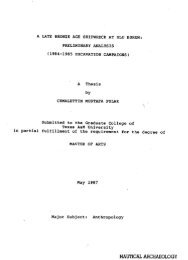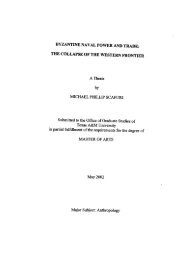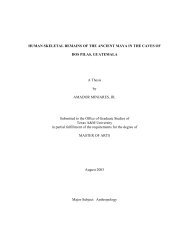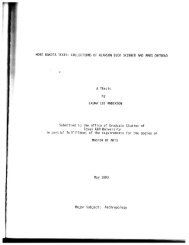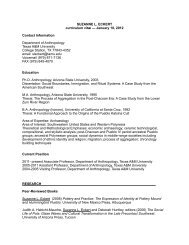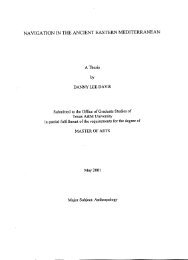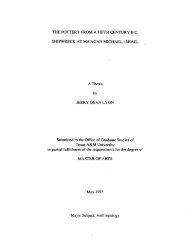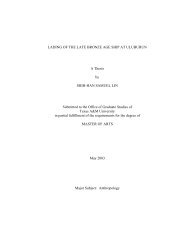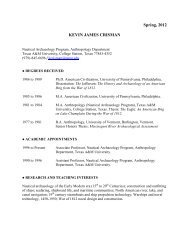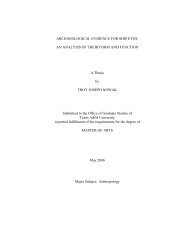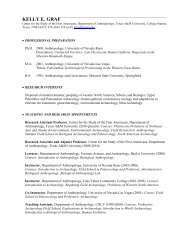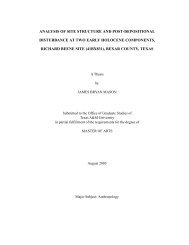- Page 1 and 2: FAIENCE AND GLASS BEADS FROM THELAT
- Page 3 and 4: iiiABSTRACTFaience and Glass Beads
- Page 5 and 6: vACKNOWLEDGMENTSI wish to acknowled
- Page 7 and 8: viiCHAPTERPageVGLASS: MATERIAL AND
- Page 9 and 10: ixLIST OF FIGURESFIGUREPage1 Locati
- Page 11 and 12: xiFIGUREPage4.3 Tiny and segmented
- Page 13 and 14: xiiiFIGUREPageB.31 Small glass bead
- Page 15 and 16: 2Fig. 1. Location of the Uluburun s
- Page 17 and 18: 4Palestinian coast to a final desti
- Page 19 and 20: 6because beads found in archaeologi
- Page 21 and 22: 8In the Aegean, beads of numerous m
- Page 23 and 24: 10dowry lists of Mitanni princesses
- Page 25 and 26: 12Faience beads were highly valued
- Page 27 and 28: 14eye beads found in Mycenaean buri
- Page 29 and 30: 16is based on Beck’s terminology
- Page 31 and 32: 18Table 2.1. Categories of faience
- Page 33 and 34: 20Inv. No. Lot 9463.bN16 LL4Beck No
- Page 35 and 36: 22found in the tomb. 8Jewelry recov
- Page 37 and 38: 24Fig. 2.3. Segmented faience beads
- Page 39 and 40: 26The shipwreck yielded around 1,60
- Page 41: 28Cogwheel BeadsInv. No. KW 2496L16
- Page 45 and 46: 32Grain-of-Wheat BeadsThis bead typ
- Page 47 and 48: 34Fig. 2.10. Grain-of-wheat variant
- Page 49 and 50: 36The grain-of-wheat beads represen
- Page 51 and 52: 38Biconical BeadsThe biconical faie
- Page 53 and 54: 40remaining beads possess 17 gadroo
- Page 55 and 56: 42Woolley’s type 17, spoked-wheel
- Page 57 and 58: 44longer and fusiform rather than b
- Page 59 and 60: 46example with all three features w
- Page 61 and 62: 48gadrooned; their form is similar
- Page 63 and 64: 50deteriorated, bead diameter is so
- Page 65 and 66: 52Fig. 2.17. Concreted mass of smal
- Page 67 and 68: 54the Greek mainland, 151 Crete, 15
- Page 69 and 70: 56At least seven segmented glass be
- Page 71 and 72: 58Large Glass BeadsInv. No. KW 2673
- Page 73 and 74: 60Fig. 2.24. Large glass bead from
- Page 75 and 76: 62that of the matrix or bead body,
- Page 77 and 78: 64most often obscuring the beads’
- Page 79 and 80: 66their infrequency in Egypt, howev
- Page 81 and 82: 68The ship came to rest on a steep
- Page 83 and 84: 70Faience BeadsThe tiny faience bea
- Page 85 and 86: 72sharing a distinct concentration
- Page 87 and 88: Fig. 3.5. Distribution of grain-of-
- Page 89 and 90: 76the distribution of plain cogwhee
- Page 91 and 92: 78Only five faience button beads we
- Page 93 and 94:
80are in close proximity, they diff
- Page 95 and 96:
82Conversely, the collared cogwheel
- Page 97 and 98:
84tomb were decorated with beads. 1
- Page 99 and 100:
86In some cases, the term faience h
- Page 101 and 102:
88variety of siliceous materials. M
- Page 103 and 104:
90glaze; the unmelted glazing powde
- Page 105 and 106:
92Although elaborate faience beads,
- Page 107 and 108:
94reconstructed as a three-sided gr
- Page 109 and 110:
96Fig. 4.2. Tiny segmented bead fro
- Page 111 and 112:
989271.a-c, figures in app. B). In
- Page 113 and 114:
100microscope; the surfaces of both
- Page 115 and 116:
102app. B) is seemingly unfinished,
- Page 117 and 118:
104end, possibly representing a loc
- Page 119 and 120:
106CHAPTER VGLASS: MATERIAL AND MAN
- Page 121 and 122:
108Assyria, Canaan, and Akkadia. 11
- Page 123 and 124:
110B.C., and also occurs with agate
- Page 125 and 126:
112k{ing}, my {l}ord, 30 (pieces) o
- Page 127 and 128:
114Glass Bead ManufactureGlass work
- Page 129 and 130:
116the formation process for stone
- Page 131 and 132:
118Manufacture of the Glass Beads F
- Page 133 and 134:
120Finally, as noted above, the per
- Page 135 and 136:
122spheroid, while the large glass
- Page 137 and 138:
124then, that faience and glass, al
- Page 139 and 140:
126Blegen, C.W., and E.P. Blegen. 1
- Page 141 and 142:
128Engle, A. 1978. Ancient Glass in
- Page 143 and 144:
130Lin, S.-H.S. 2003. “Lading of
- Page 145 and 146:
132Persson, A.W. 1931. The Royal To
- Page 147 and 148:
134Tufnell, O., C.H. Inge, and L. H
- Page 149 and 150:
136APPENDIX AGLOSSARY OF TERMSAmygd
- Page 151 and 152:
138PerforationHole along the bead a
- Page 153 and 154:
140APPENDIX BSAMPLE BEAD DIMENSIONS
- Page 155 and 156:
142Table B.1 ContinuedInv. No. Beck
- Page 157 and 158:
Fig. B.2. Tiny faience beads KW 988
- Page 159 and 160:
Fig. B.4. Tiny faience beads Lot 10
- Page 161 and 162:
148Table B.2. Sample dimensions of
- Page 163 and 164:
150Table B.2 ContinuedInv. No. Beck
- Page 165 and 166:
Fig. B.7. Globular faience beads KW
- Page 167 and 168:
Fig. B.9. Globular faience beads Lo
- Page 169 and 170:
156Table B.3. Sample dimensions of
- Page 171 and 172:
158Table B.3 ContinuedInv. No. Beck
- Page 173 and 174:
Fig. B.12. Cogwheel faience beads K
- Page 175 and 176:
Fig. B.14. Cogwheel faience beads K
- Page 177 and 178:
164Table B.4. Sample dimensions of
- Page 179 and 180:
166Table B.5. Sample dimensions of
- Page 181 and 182:
168Table B.6. Sample dimensions of
- Page 183 and 184:
Fig. B.17. Grain-of-wheat variant A
- Page 185 and 186:
Fig. B.19. Grain-of-wheat variant A
- Page 187 and 188:
Fig. B.21. Grain-of-wheat faience b
- Page 189 and 190:
176Table B.8 ContinuedMolded Face I
- Page 191 and 192:
Fig. B.22. Biconical variant A faie
- Page 193 and 194:
Fig. B.24. Biconical faience beads,
- Page 195 and 196:
Fig. B.25. Grooved barrel faience b
- Page 197 and 198:
184Table B.13. Sample dimensions of
- Page 199 and 200:
186Table B.13 ContinuedInv. No. Bec
- Page 201 and 202:
Fig. B.28. Small glass beads KW 148
- Page 203 and 204:
Fig. B.30. Small glass beads KW 148
- Page 205 and 206:
Fig. B.32. Small glass beads KW 148
- Page 207 and 208:
Table B.14 ContinuedInv. No. Beck N
- Page 209 and 210:
Fig. B.33. Large glass beads KW 148
- Page 211 and 212:
Fig. B.35. Large glass beads Lot 98
- Page 213 and 214:
Fig. B.37. Large glass beads Lot 98
- Page 215 and 216:
Fig. B.39. Large glass beads Lot 98
- Page 217 and 218:
Fig. B.41. Large glass beads Lot 98
- Page 219 and 220:
206APPENDIX CESTIMATES OF BEADS IN
- Page 221 and 222:
208As these beads approximate to sp
- Page 223:
210VITARebecca Suzanne IngramDate o



